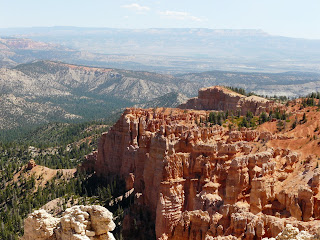 One of the reasons I love Utah's National Parks is that they are literally groundswells of geology in action. I have no interest in flora and very little interest in fauna, but I have a passion for geology. I love its all-but-infinite time horizons, its grandiosely broad perspective, its eloquence and its ubiquity.
One of the reasons I love Utah's National Parks is that they are literally groundswells of geology in action. I have no interest in flora and very little interest in fauna, but I have a passion for geology. I love its all-but-infinite time horizons, its grandiosely broad perspective, its eloquence and its ubiquity.The geologic story of Bryce Canyon - and of Utah's other National Parks - is primarily a story of water. Rock formations result from erosion, and erosion, even in the desert, is water's handiwork. The day-to-day freeze-thaw cycle of dew, rain, ice and snow sculpts rock by working its expansion-contraction magic over geologic time.
About 60 million years ago, the basin that covered most of southern Utah began to fill with fresh water. For millions of years, rivers and streams from surrounding mountains filled the lake in the basin with silts, clays and sands. Calcium carbonate glued these sediments together and formed the limestone from which Bryce Canyon was carved.
About 16 million years ago, southern Utah began to rise as large faults in the earth's crust pushed up a series of plateaus. The Paunsaugunt Plateau rose from sea level to approximately 8000 feet. The Aquarius Plateau, just to the east, rose 2000 feet higher still. Water erosion began to wear away the limestone even as the plateaus were still rising. Eventually, the softer stone washed away, leaving the spires, arches, walls and, finally, the hoodoos of Bryce Canyon.
Hoodoos are the pinnacles left behind when ridges, walls and arches wear away and collapse. They go last because they're protected by a layer of harder caprock called dolomite. This erodes too, but at a much slower rate. The differential erosion rates are what cause the crazy shapes. Dolomite can't protect the hoodoos forever, though; they, too, eventually collapse.
One of the coolest things about rock formations like Bruce Canyon is their ephemerality. They seem, and indeed are, permanent when viewed in human terms. But in geologic terms, they are provisional, fleeting, as mortal as we are. Geology has all the time in the world and, given all that time, the same forces that created Bryce Canyon will reduce it to rubble and then replace it with something equally spectacular - again and again and again.
With that said, I'll let profound beauty speak for itself:















4 comments:
Stunning views (i'm a views person) very interesting read, thanks for sharing.
Brian
So Beautiful!!!!
Ahhhh... makes me miss Colorado! BTW, my aunt & uncle own a great store in Moab (www.earthstudiomoab.com), so I've been to that area (Canyonlands, Arches) and LOVED it. Gorgeous photos, Debra - and again, love the descriptions. You not only paint a picture in my head, but you tell me the "why" behind the beauty. Bravo.
I remember it well, one of the highlights of my holiday a few years ago. That 'hoodoo' word brings back memories!
I recall staring into this canyon for ages then spotting some strange little shapes moving along that suddenly came into focus as people; my sense of perspective had been totally out. I live in a flat, crowded landscape, so such 'contra-zoom' moments are rare and special.
Post a Comment